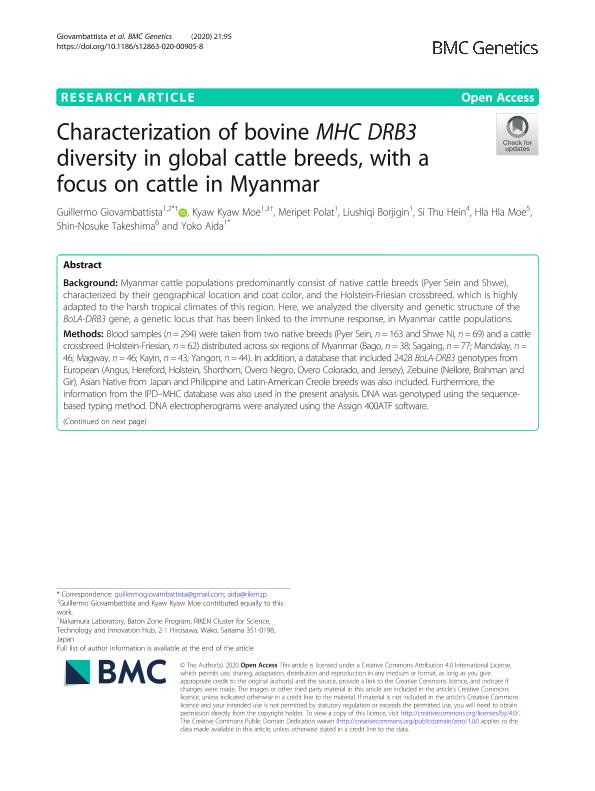Artículo
Characterization of bovine MHC DRB3 diversity in global cattle breeds, with a focus on cattle in Myanmar
Giovambattista, Guillermo ; Moe, Kyaw Kyaw; Polat, Meripet; Borjigin, Liushiqi; Hein, Si Thu; Moe, Hla Hla; Takeshima, Shin Nosuke; Aida, Yoko
; Moe, Kyaw Kyaw; Polat, Meripet; Borjigin, Liushiqi; Hein, Si Thu; Moe, Hla Hla; Takeshima, Shin Nosuke; Aida, Yoko
 ; Moe, Kyaw Kyaw; Polat, Meripet; Borjigin, Liushiqi; Hein, Si Thu; Moe, Hla Hla; Takeshima, Shin Nosuke; Aida, Yoko
; Moe, Kyaw Kyaw; Polat, Meripet; Borjigin, Liushiqi; Hein, Si Thu; Moe, Hla Hla; Takeshima, Shin Nosuke; Aida, Yoko
Fecha de publicación:
09/2020
Editorial:
BioMed Central
Revista:
BMC Genetics
ISSN:
1471-2156
Idioma:
Inglés
Tipo de recurso:
Artículo publicado
Clasificación temática:
Resumen
Background: Myanmar cattle populations predominantly consist of native cattle breeds (Pyer Sein and Shwe), characterized by their geographical location and coat color, and the Holstein-Friesian crossbreed, which is highly adapted to the harsh tropical climates of this region. Here, we analyzed the diversity and genetic structure of the BoLA-DRB3 gene, a genetic locus that has been linked to the immune response, in Myanmar cattle populations. Methods: Blood samples (n = 294) were taken from two native breeds (Pyer Sein, n = 163 and Shwe Ni, n = 69) and a cattle crossbreed (Holstein-Friesian, n = 62) distributed across six regions of Myanmar (Bago, n = 38; Sagaing, n = 77; Mandalay, n = 46; Magway, n = 46; Kayin, n = 43; Yangon, n = 44). In addition, a database that included 2428 BoLA-DRB3 genotypes from European (Angus, Hereford, Holstein, Shorthorn, Overo Negro, Overo Colorado, and Jersey), Zebuine (Nellore, Brahman and Gir), Asian Native from Japan and Philippine and Latin-American Creole breeds was also included. Furthermore, the information from the IPD-MHC database was also used in the present analysis. DNA was genotyped using the sequence-based typing method. DNA electropherograms were analyzed using the Assign 400ATF software. Results: We detected 71 distinct alleles, including three new variants for the BoLA-DRB3 gene. Venn analysis showed that 11 of these alleles were only detected in Myanmar native breeds and 26 were only shared with Asian native and/or Zebu groups. The number of alleles ranged from 33 in Holstein-Friesians to 58 in Pyer Seins, and the observed versus unbiased expected heterozygosity were higher than 0.84 in all the three the populations analyzed. The FST analysis showed a low level of genetic differentiation between the two Myanmar native breeds (FST = 0.003), and between these native breeds and the Holstein-Friesians (FST < 0.021). The average F ST value for all the Myanmar Holstein-Friesian crossbred and Myanmar native populations was 0.0136 and 0.0121, respectively. Principal component analysis (PCA) and tree analysis showed that Myanmar native populations grouped in a narrow cluster that diverged clearly from the Holstein-Friesian populations. Furthermore, the BoLA-DRB3 allele frequencies suggested that while some Myanmar native populations from Bago, Mandalay and Yangon regions were more closely related to Zebu breeds (Gir and Brahman), populations from Kayin, Magway and Sagaing regions were more related to the Philippines native breeds. On the contrary, PCA showed that the Holstein-Friesian populations demonstrated a high degree of dispersion, which is likely the result of the different degrees of native admixture in these populations. Conclusion: This study is the first to report the genetic diversity of the BoLA-DRB3 gene in two native breeds and one exotic cattle crossbreed from Myanmar. The results obtained contribute to our understanding of the genetic diversity and distribution of BoLA-DRB3 gene alleles in Myanmar, and increases our knowledge of the worldwide variability of cattle BoLA-DRB3 genes, an important locus for immune response and protection against pathogens.
Archivos asociados
Licencia
Identificadores
Colecciones
Articulos(IGEVET)
Articulos de INST.DE GENETICA VET ING FERNANDO NOEL DULOUT
Articulos de INST.DE GENETICA VET ING FERNANDO NOEL DULOUT
Citación
Giovambattista, Guillermo; Moe, Kyaw Kyaw; Polat, Meripet; Borjigin, Liushiqi; Hein, Si Thu; et al.; Characterization of bovine MHC DRB3 diversity in global cattle breeds, with a focus on cattle in Myanmar; BioMed Central; BMC Genetics; 21; 1; 9-2020; 1-17
Compartir
Altmétricas



